1966 Quarter Coin Value: How Much Is It Worth?
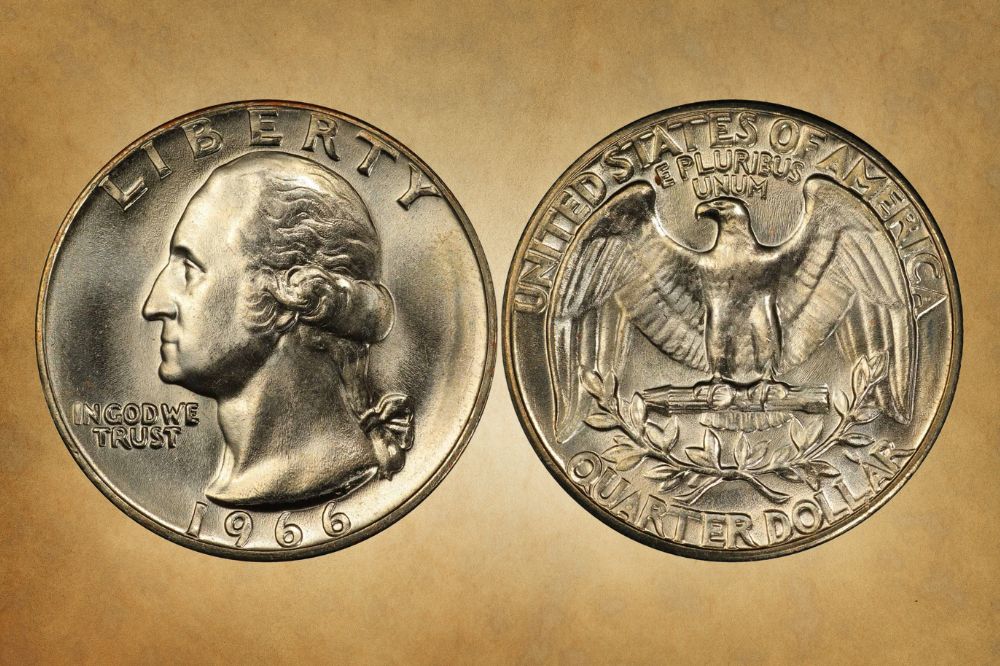
If you’ve found a 1966 quarter in your change, you might be wondering what it’s worth. If so, you’ve come to the right place!
We’re going to look at the 1966 quarter value, its history and interesting features. And we’ll discover unusual errors that turn ordinary coins into something extraordinary – and valuable.
So if you’re ready to find out more, step this way!
1966 Quarter Value Chart |
||||
| Mintmark or Variety | XF45 | MS63/SP63 | MS65/SP65 | MS67/SP67 |
| 1966 (P) No Mint Mark Quarter Value | $0.25 | $1 | $14 | $275 |
| 1966 (S) Special Mint Set | $0.25 | $10Cameo: $16
Deep Cameo: $32 |
$14Cameo: $32
Deep Cameo: $165 |
$26Cameo: $85
Deep Cameo: $2,650 |
1966 Quarter Value Guides
1966 (P) No Mint Mark Quarter Value
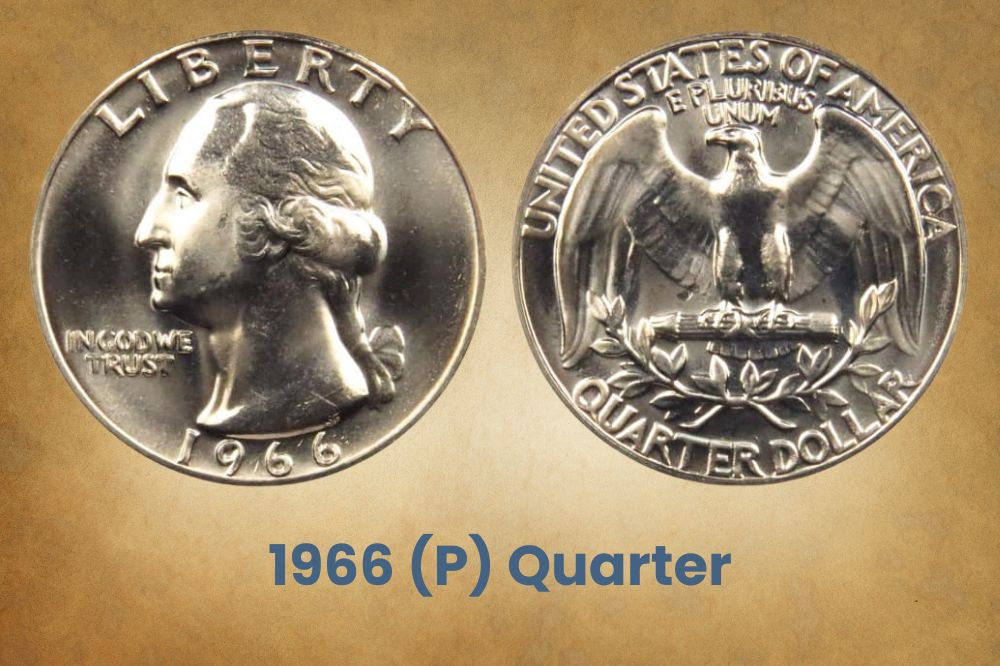
As we’ve seen, none of the quarters minted in 1966 carry mint marks. Some coins without mint marks were nevertheless struck in multiple facilities. But the 1966 circulation quarter was struck only in Philadelphia.
Over 821 million coins came out of that facility. So less than 60 years on, it’s not difficult to find examples today. That means that most 1966 quarters aren’t worth anything more than their face value, i.e. 25 cents.
But if you can find a coin in excellent uncirculated condition, it will be worth more. These coins are known as “mint state”, abbreviated to MS in the coin descriptions from grading agencies.
Mint state coins can be graded from 60 to 70, with 70 reserved for perfect coins. Coins graded MS65 and above are known as “gem quality”.
It’s not until MS63 that a 1966 quarter is worth much more than 25 cents. The independent coin grading agency, the PCGS, values an MS63 example at $1. That increases to $14 at MS65 and $275 at MS67.
The finest known 1966 quarter is a single coin grade MS68+. That’s never changed hands since coming to light, but it’s valued at about $17,500. The auction record goes to a 1966 quarter graded MS68, which sold in 2019 for $11,750.
1966 (S) Special Mint Set Quarter Value
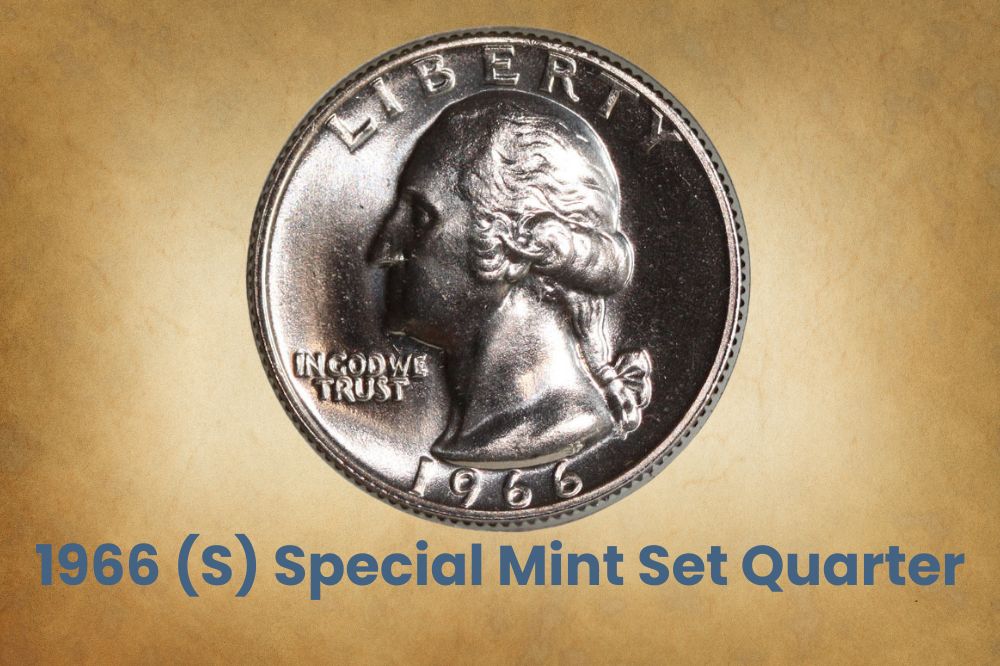
No proof quarters were struck in 1966. Instead, the San Francisco mint facility struck over 2.26 million quarters for what’s known as “Special Mint Sets”. Unlike proofs, they were struck on unpolished planchets, and were allowed to come into contact with other coins.
The Special Mint Sets were issued by the Mint and included one example of every denomination from that year. They were targeted at collectors, so most were stored away with care. That means it’s still very easy to find good quality coins today, limiting their value.
Special Mint Set (SMS) coins are graded with an SP number, rather than MS (or PR for proofs). Like proofs, they can be given a “cameo” or “deep cameo” designation. These reflect the quality of the coin and the strike.
With cameo coins, there’s an attractive contrast between reflective fields (the flat parts of the coin) and frosted design elements. With a deep cameo coin, this contrast is even more pronounced.
All other things being equal, a deep cameo will be more valuable than a cameo. And a cameo will in turn be more valuable than an undesignated coin.
An SMS 1966 quarter without a designation can range in value from around $10 at SP63, to over twice that at SP67. The most valuable known examples are graded SP68 by the PCGS, and they’re worth around $40.
A cameo designation increases the value to $16 at SP63, and $85 at SP67. The equivalent values for deep cameos are $32 and $2,650.
The auction record for a 1966 cameo quarter is $4,113, achieved in 2014 for a coin graded SP68. The finest known example of a 1966 quarter with the deep cameo designation is also graded SP68. The PCGS values it at $6,250.
Related Posts: 17 Most Valuable Modern Quarters Worth Money
1966 Quarter Errors
1966 Double Die Reverse Eagle Quarter
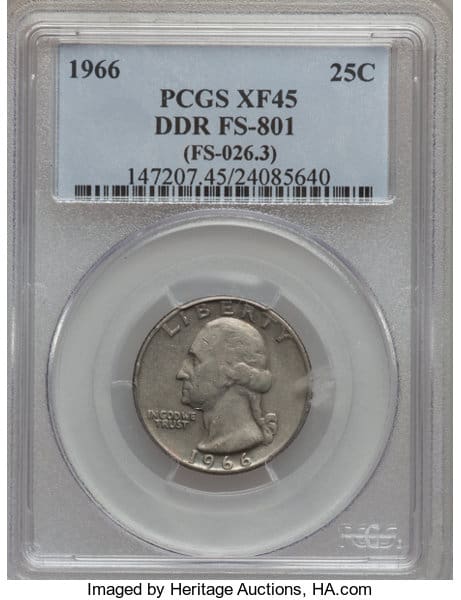
Coins with double die errors result from an error when the die used to strike them was being made.
In the past, in order to get every detail of the design, a die had to be struck more than once. If it moved between strikes, it would be left with the shadow of a second design. This double image would then be transferred to the coins struck by that die.
The 1966 quarters include a number of coins struck with a reverse die with a double image. You can spot the doubling on the lettering of “UNITED STATES OF AMERICA” (especially in the “T”s in “STATES) . It can also be seen in the denomination.
These coins are highly sought after by collectors. Mint state examples are unknown. But a 1966 quarter with a double die reverse graded “extremely fine” (XF45) is today valued at around $900. And in “very fine” condition, examples have sold at auction for around $140.
Foreign Objects
Very occasionally, a foreign object finds its way into the coin presses. That happened with one 1966 quarter, where a piece of magnetic metal was struck into the obverse. To add to the interest, the piece of metal was shaped like a horseshoe.
The coin was graded by the PCGS at MS64, and sold at auction for over $600.
Struck Off-Center
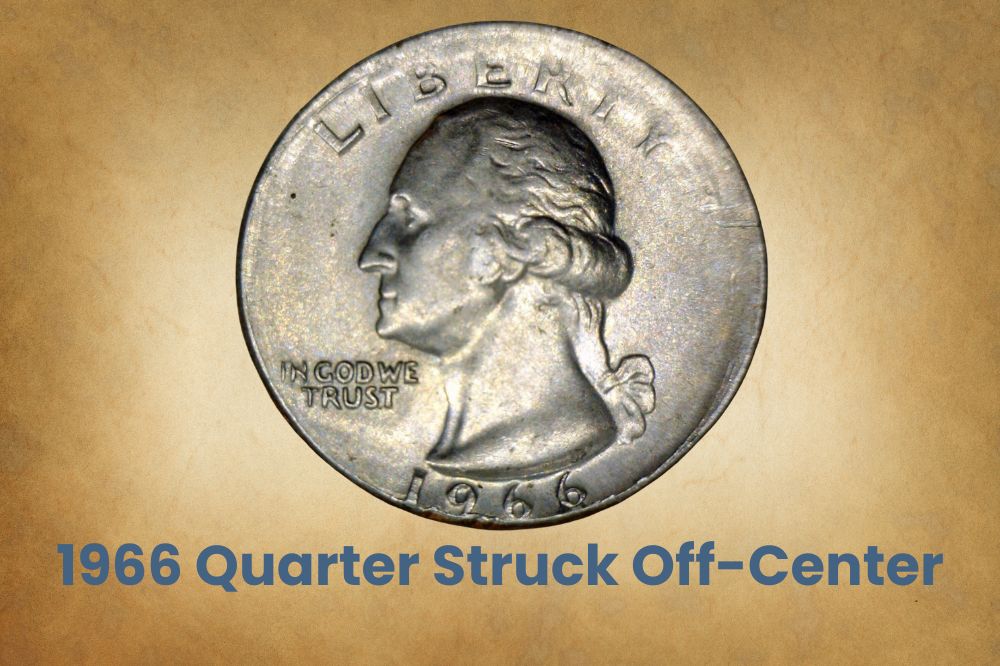
Sometimes, planchets aren’t in the right position when they’re struck. That results in a coin with an image that’s off-center. And depending on how far off-center it is, such errors can be valuable.
One 1966 quarter was struck 30 per cent off-center. And it had a 60 per cent indent into the bargain. To the untutored eye, the coin looks a bit of a mess. But because mint errors like these are so rare, it’s highly collectible.
It was graded MS64 by the PCGS, and sold at auction for over $800.
Take a look at this YouTube video from Couch Collectibles to learn more about 1966 quarter errors, how to spot them, and what they’re worth.
Related Posts: 16 Most Valuable Quarter Errors
History of the 1966 Quarter
The quarter minted in 1966 is one of a series known as Washington quarters. They were first struck in 1932, celebrating the bicentenary of George Washington’s birth. And it’s the first president of the US who appears on the obverse and gives these coins their popular name.
The first Washington quarters were made of 90 per cent silver. But that changed in 1965, when rising silver prices were putting pressure on the coins. The increasing value of their metal content meant that people started to hoard them, hoping to make a profit.
That meant fewer coins in circulation, as well as ever higher production costs. Something had to give, and in 1965 it was decided to change the composition of the coins. The old silver quarter was replaced with a coin with a copper core. And to keep its silver look, the copper was clad in an alloy of copper and nickel.
It wasn’t only the quarter that changed at this time. The composition of the dime was changed in the same way. And the amount of silver in the half dollar was reduced from 90 to 40 per cent.
The new composition meant that some changes to the design were needed. The raised areas were lowered so that it was possible to get excellent detail across the whole design.
The 1966 quarters were all struck without mint marks. And coins with this date weren’t struck from January of that year. This was another result of measures to prevent coins being hoarded.
Back in 1964, Congress authorized coins struck in 1965 to continue to be dated 1964. More 1964 silver coins, it was believed, would make people less likely to hold onto them. It didn’t work – but the decision had knock-on implications for the succeeding mintages.
Quarters dated 1965 didn’t begin to be struck until July of that year. And quarters dated 1966 were first struck in August 1966.
Related Posts: Top 10 Most Valuable Bicentennial Quarters Worth Money
How to identify 1966 Quarter
The Obverse of the 1966 Quarter
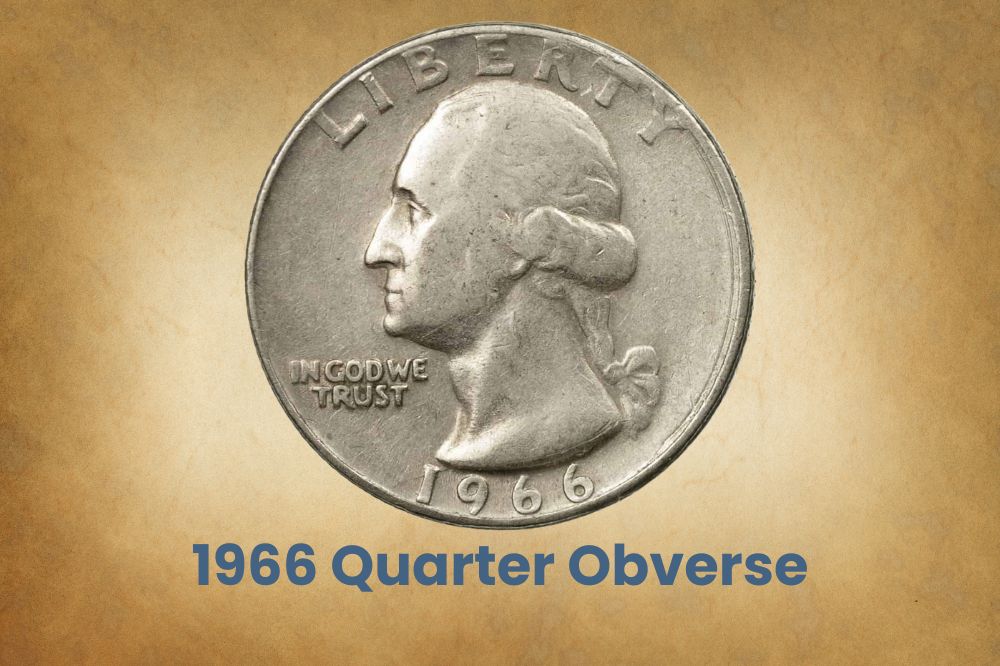
Look at the obverse, or “heads” side, of a Washington quarter and you’ll see a portrait of the man from whom they take their nickname. George Washington, first president of the USA, appears in profile facing to the left.
His image is the work of one John Flanagan. And it’s based on an earlier bust by the French sculptor Jean-Antoine Houdon.
Houdon’s bust was considered the definitive Washington depiction. It had already been used on a half dollar minted to celebrate the 150th anniversary of the Declaration of Independence.
Flanagan’s portrait differed in some respects, most notably in adding a roll of hair at the back of Washington’s head. And the choice of his design attracted some controversy.
It had originally been intended to commemorate the bicentenary of Washington’s birth with a single-year half-dollar coin. A committee set up to oversee all aspects of the celebrations had already selected a portrait of Washington by another artist, Laura Gardin Fraser.
But when it was decided to commemorate Washington with a permanent quarter instead, the Treasury ran a new competition. And the Treasury Secretary, Andrew W. Mellon, preferred Flanagan’s portrait.
The committee disagreed, and when Flanagan was succeeded by Ogden L. Mills, they asked him to reconsider. Mills declined, and in 1932 the first Washington quarters were issued with Flanagan’s portrait.
Above it appears the word “Liberty”, and the date is at the bottom. The motto, “In God we trust” appears on the left of the coin, level with Washington’s neck. In later years, the mint mark would appear to the right of Washington’s neck. But you won’t find a 1966 quarter with a mint mark.
The Reverse of the 1966 Quarter
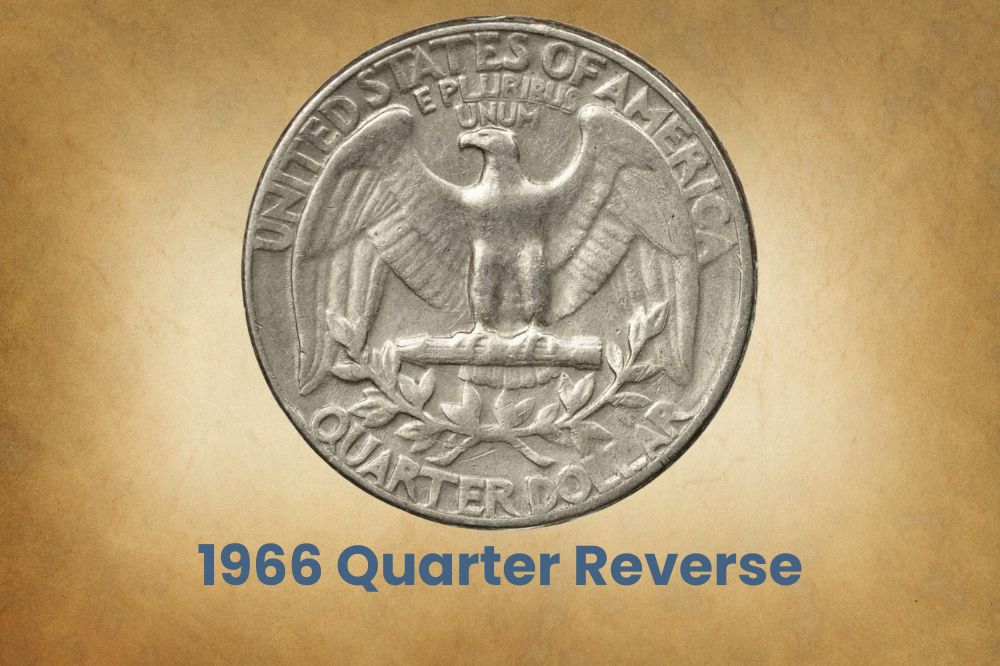
The reverse of the 1966 quarter carries another design by Flanagan. An eagle perches on a fletch of arrows, its wings stretched out wide. Below the arrows, two olive branches tied together signify peace.
The image of the eagle is bold, taking up almost all the coin face. The country name is inscribed above it, along a curve that follows the edge of the coin.
Below it, and immediately above the eagle’s head, are the words “E pluribus unum”. The Lain motto means “From the many, one”. It appears on all US coins and refers to the creation of the country from the many individual states.
The denomination is inscribed along the bottom edge of the coin. It’s written in full as “QUARTER DOLLAR”.
In earlier mintages of the quarter, the reverse design differs very slightly between proof and other coins. The easiest way to spot the difference is by looking at the letters “ES” in “UNITED STATES OF AMERICA”. In circulation strikes, the letters almost touch. In proof coins, they’re quite separate.
By 1966, however, the reverse designs used for all quarters were the same.
Other Features of the 1966 Quarter
In common with other quarters struck from 1965 onwards, the 1966 quarter measures 24.3 millimeters across and weighs 5.67 grams. That makes it somewhat lighter than the earlier silver quarters, which weigh in at 6.25 grams.
Turn the coin on its side, and you’ll see a series of parallel grooves running around the edge. This is what’s known as a “reeded edge”. It was originally introduced in the eighteenth century to make it obvious if precious metal had been clipped from the edges of gold and silver coins.
This YouTube video from BigDCoins looks at the 1966 quarter in more detail. And it also compares it to other quarters from the same era.
Related Posts: 20 Most Valuable State Quarters Worth Money
FAQs
How do I know if my 1966 quarter is worth anything?
1966 quarters were made in large numbers, so the vast majority will be worth only their face value. But if your coin is in exceptionally good condition – with every detail of the design sharp, and without scratches or hairlines – it could be worth more.
Error coins can be valuable too, though it’s important to distinguish mint errors from subsequent damage. Look out for doubling on the reverse of the coins, particularly in the “T”s of “States”. These coins are highly collectable.
Where’s the mint mark on a 1966 quarter?
If you’re looking for a mint mark on a 1966 quarter, you’ll be looking for a long time! Neither the circulation coins struck in Philadelphia, nor the coins for Special Mint Sets struck in San Francisco, carry a mint mark.
It’s the same for quarters struck in 1965 and 1967. In later years, you’ll find the mint mark on the obverse, to the right of Washington’s neck.
Related Posts: 21 Most Valuable Quarters In Circulation

I have a 1966 quarter, it is a gold tone, looks like it is silver but not sure. What do I have? Thank You.